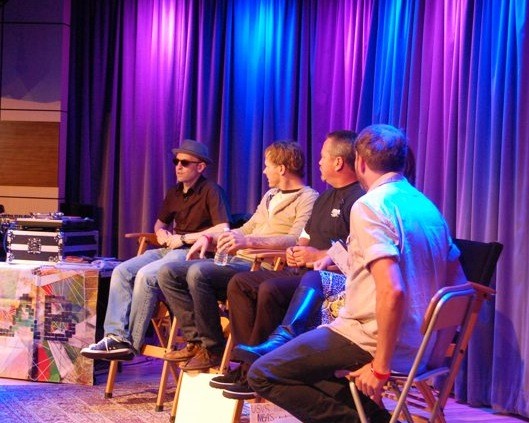
Last night the Grammy Museum in Los Angeles hosted a panel discussion on the process of vinyl production as it pertains to small artists. Among the four panelists on stage at the Clive Davis Theatre was Infrasonic Sound owner/mastering engineer Pete Lyman, who was featured in my recent cover story on the resurgence of records in recent years. The discussion reinforced what people in the business have known for some time–that despite the recent increase in vinyl sales, it's still an indie band's game.
And the consensus at last night's discussion wasn't that any yuck with a garage band should start pressing platters; rather, the goal was to give an idea of what goes into the process and what the options are. Rule number one: It ain't cheap. A quick estimate of the services from cutting the laquer, to pressing the product to manufacturing the jackets yielded a base total just north of $2,000.
]
Offering a comprehensive of the overall process, Lyman was joined on
the stage of the Clive Davis theater by DJ/producer/label owner Peanut
Butter Wolf, vinyl pressing plant operator Kevin Smith and Jennifer
Freund CEO of Dorado Packaging, which manufactures album covers. The
panel was moderated by the owner of Echo Park-based Origami Vinyl, Neil
Shield, He explained that though his business is profitable, he doesn't
move massive quantities of product. He estimated he sold only 75 copies
of Beach House's album last year. “I'm not saying don't do it. I'm
saying be smart about the decisions you make,” Shield said.
There were
several moments throughout the hour-long discussion that tread into heavy
tech talk and saw such terms as phase issues, tracing distortion
and bit rate being thrown around with abandon, there were plenty of pithy nuggets of wisdom to glean.
Here are some things Joe Indie Band might want to consider before
embarking on this process:
fancy vinyl can lead to issues with audio quality. “Transparent colors
tend to have a little more surface noise,” explained Smith.
optimum sound quality, keep the album at 15 minutes per side. Lyman explained that it's because of the spacing of the grooves, as well as the
angle of the tone arm on the record player and the surface covered at
different points on the vinyl which can cause “tracing distortion.” Of
course if you really need record your opus, there's always the option
of pressing a double LP. “Most records I cut these days are 20 minutes
a side,” says Lyman.
finished mastering your record to send artwork to the printer.
Differences in calibration between your computer and the printer's
computer can lead to disappointment down the road. There's also lots of
choices to make about the types of folds, UV coatings and varnishes.
“While you're visiting Pete, submit your art,” said Freund.
there are options as to the gram weight of vinyl, last night's panelists don't subscribe to the notion that a record has to
be pressed on 180 gram vinyl to sound good. “There are some myths out
there,” Lyman said about people's conceptions of 180 gram. “(People
say) the grooves are cut deeper so it sounds better, which is
completely untrue.” Added Smith, “We try and stay in the 140, 150 gram
range.”
records if you can't move them. The last thing you want is a garage full
of unsold records–it's bad for band morale. Kevin Smith will accept orders for as few
as 50 records, with the band maintaining possession of the stampers. You can
always make more. Summing up his business model, Smith related a
quote handed down by his father “Stay with the small guy. He's the one
that will always come back to you.”

